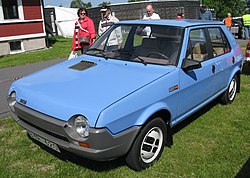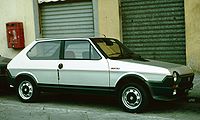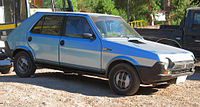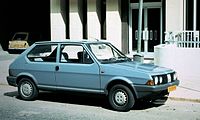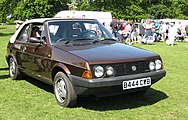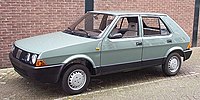Fiat Ritmo
| Fiat | |
|---|---|
|
Fiat Ritmo (1978-1981)
|
|
| Ritmo | |
| Production period: | 1978-1988 |
| Class : | Compact class |
| Body versions : | Station wagon , convertible |
| Engines: |
Otto engines : 1.1–2.0 liters (40–96 kW) Diesel engines : 1.7–1.9 liters (43–59 kW) |
| Length: | 3940 mm |
| Width: | 1651 mm |
| Height: | 1400 mm |
| Wheelbase : | 2445 mm |
| Empty weight : | 820-980 kg |
| Previous model | Fiat 128 |
| successor | Fiat Tipo |
The Fiat Ritmo is a compact class vehicle built by the automobile manufacturer Fiat from spring 1978 to the end of 1988 . It replaced the Fiat 128 built since 1969 .
Its body shape with the gray bumper panels pulled up high took some getting used to. In the front they had slits to replace the grille and reached between the headlights. In the fall of 1982 there was, among other things, a conventionally designed bow with a grille and double headlights.
The Fiat Bravo has been offered as Fiat Ritmo in Australia since 2008 because Mazda already has the Mazda Bravo in its range there.
Model history
General
In April 1978 Fiat introduced the Ritmo. Fiat adopted the technical concept from the 128. The Fiat Ritmo was offered in two body styles:
- Hatchback with three or five doors,
- Convertible with fabric roof and roll bar, manufactured by Bertone .
The large front and rear aprons ("protective shields") made of gray plastic - with narrow taillights, are striking . The plastic parts in the interior were set off in two colors in the course of the first series so as not to make them look too dreary.
The engine with engine block made of gray cast iron , aluminum cylinder head, crankshaft with five bearings and overhead , toothed belt-driven camshaft was installed transversely at the front, next to it the gearbox with the differential. Drive shafts of unequal length drove the front wheels. All wheels were suspended individually , at the front on MacPherson struts and wishbones, at the rear on shock absorber struts and trapezoidal wishbones with a transverse leaf spring. The steering acts via a pinion and a rack on short tie rods. Disc brakes are installed at the front and drum brakes at the rear. The service brake works with two hydraulic circuits, the handbrake acts on the rear drum brakes via cables.
In early 1981 all models received redesigned exterior mirrors. The Fiat logo previously attached to the bonnet was also replaced by the “laurel wreath” placed in the middle of the front protective shield. The last Targa Oro models also received this change. The cabriolet designed and built by Bertone, with its roll bar similar to the VW Golf Cabrio , appeared at the end of 1981.
Facelift
In October 1982 the Ritmo received a modified front (with twin headlights and five inclined chrome steel bars), large rear lights and other bumpers. Originally there was only the normal and the S version, with the appearance of the L version (recognizable by single headlights) there was also a CL again .
At the same time, the fuel tank previously installed under the trunk was moved under the rear seat bench and the body structure was reinforced to improve passive safety . The tank filler neck was now with the cover flush with the body above the right rear wheel. Furthermore, from April 1985 the Ritmo 60 S was also marketed in a fuel-saving version called "Energy Saving".
In September 1985 it was further revised. The five-door Ritmo received square door handles, the rear license plate was integrated into the bumper, the shape of the radiator grille was changed and the equipment upgraded. A 1.6-liter gasoline engine with 100 hp (74 kW) was also added.
Due to the ever more stringent emission regulations at that time, some versions were not available for sale in various countries. In Germany, the Ritmo 75 with a low-compression 1.5-liter engine with 75 HP (55 kW) was offered as one of the first vehicles with catalytic converters. It was suitable for regular unleaded gasoline and equipped with an unregulated Cromodora catalytic converter. This version with an unregulated catalytic converter was only available from the beginning of 1986 to the end of 1987, the mixture was still processed by a carburetor (with choke ). Then there was the Ritmo with a regulated catalytic converter according to US standards and an injection system as the Ritmo 75 ie .
For a while, only the 70 hp petrol engine (51 kW) and the turbodiesel were available in Austria.
In May 1987 the production of the Ritmo convertible was stopped. There was no successor. It was not until April 1994 that a Fiat convertible was available again with the open version of the Punto .
From January 1988 the Ritmo was only available with the 75 hp 1.5-liter engine with catalytic converter.
Production of the three- and five-door versions of the Ritmo ended in November 1988. He was succeeded by Fiat Tipo , which won the title of " Car of the Year " in 1989 .
Other variants
Seat Ritmo / Ronda / Malaga
At the beginning of 1979 the production of the Seat Ritmo began, which was renamed Ronda in the summer of 1982 following the separation of the two brands Fiat and Seat after an optical and technical revision . In the spring of 1985 the notchback version of Malaga was added, which also replaced the Ronda after production ended in late autumn 1986.
At the beginning Fiat wanted to prevent the construction of the Ronda after the license expired by filing a lawsuit, but this failed.
Fiat Regata / Strada
In the late summer of 1983, the Fiat Regata appeared as the successor to the 131 Mirafiori . Technically it was based on the Ritmo, but with a notchback body. In autumn 1984 the station wagon version called Weekend followed . Production of both Regata variants was discontinued in early 1990.
After the UK and in the USA the Ritmo was as Fiat Strada exported.
Introzzi Villa d'Este
The Lombard bodywork company Officine Introzzi refined some two-door Ritmos. The series, named after a palace on Lake Como, Villa d'Este , was externally recognizable by a very wide C-pillar and a roof covered with vinyl . In the interior, the vehicles were equipped with leather upholstery, a television and a dictation machine.
Equipment variants
The equipment options were:
1978 to 1982:
- L.
- CL
- great
- 105 TC
- 125 TC Abarth (sports version)
- Special series Targa Oro (brown metallic paint, brown Alcantara interior, rev counter)
1982 to 1988:
- Basic model (later CL)
- L (below the CL version, recognizable by single headlights)
- great
- Energy Saving (fuel saving model)
- 130 TC Abarth
Engine variants
The Ritmo was offered with various petrol and diesel engines :
Petrol engines
- 1.05 l, 44 kW / 60 PS (09 / 1978-09 / 1982)
- 1.1 l, 40 kW / 55 PS (10 / 1982-10 / 1985)
- 1.1 l, 43 kW / 58 PS (04 / 1985-12 / 1987)
- 1.3 l, 48 kW / 65 PS (03 / 1978-08 / 1985)
- 1.3 l, 50 kW / 68 PS (01 / 1983-04 / 1985)
- 1.3 l, 55 kW / 75 PS (01 / 1981-09 / 1982)
- 1.5 l, 55 kW / 75 PS (03/1978–11/1988)
- 1.5 l, 58 kW / 79 hp (08 / 1985–05 / 1987)
- 1.5 l, 60 kW / 82 PS (01 / 1983-12 / 1987)
- 1.6 l, 66 kW / 90 PS (09 / 1985-12 / 1987)
- 1.6 l, 74 kW / 100 PS (01 / 1983-12 / 1987)
- 1.6 l, 77 kW / 105 PS (05 / 1981-12 / 1987)
- 2.0 l, 92 kW / 125 PS (11 / 1981-09 / 1982)
- 2.0 l, 96 kW / 131 PS (04 / 1983-12 / 1987)
diesel
- 1.7 l, 40 kW / 55 PS (10 / 1979-09 / 1982)
- 1.7 l, 43 kW / 58 PS (10 / 1979-10 / 1985)
- 1.7 l, 45 kW / 60 PS (05 / 1985-12 / 1987)
- 1.9 l, 59 kW / 80 PS (turbodiesel; 12 / 1985-12 / 1987)
Web links
Literature and publications
- Oldtimer Markt February 2009 - “Turin Tact 30 Years Fiat Ritmo”, published on January 29, 2009
Individual evidence
- ↑ Alessandro Sannia: Enciclopedia dei carrozzieri italiani, Aesthetica 2017, ISBN 978-8896796412 , p. 304
- ^ Auto Catalog No. 25 (1981/82), p. 109.
